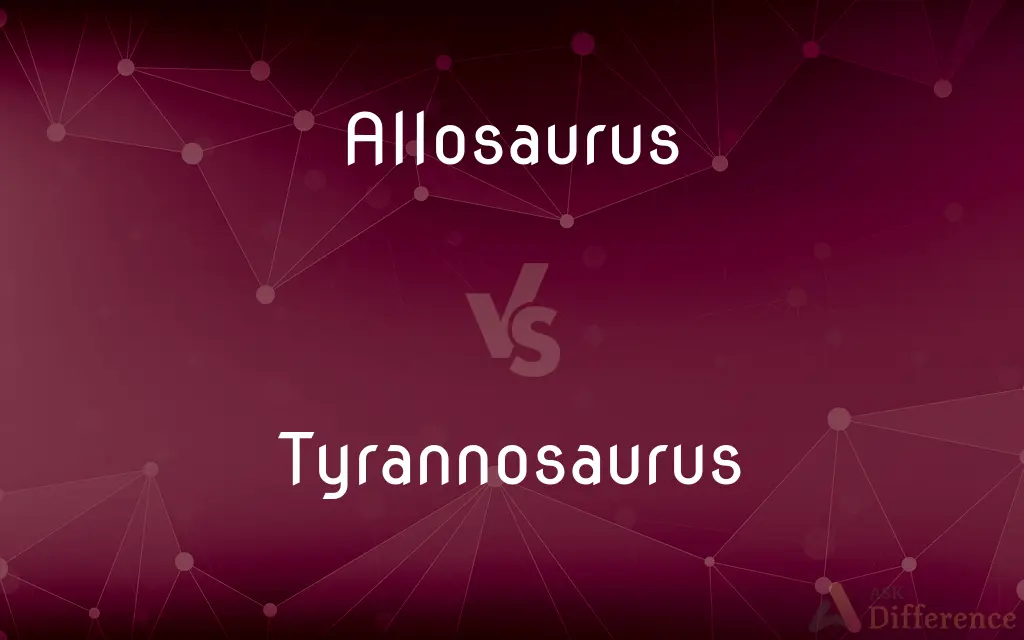Allosaurus vs. Tyrannosaurus — What's the Difference?
By Tayyaba Rehman — Updated on September 21, 2023
Allosaurus lived in the Jurassic period, while Tyrannosaurus thrived in the Cretaceous. Both are theropods, but they existed millions of years apart.

Difference Between Allosaurus and Tyrannosaurus
Table of Contents
ADVERTISEMENT
Key Differences
Allosaurus was a predator that roamed the Earth during the Late Jurassic period, approximately 150 million years ago. Tyrannosaurus, commonly known as T. rex, existed much later, during the Late Cretaceous period, about 68-66 million years ago.
In terms of size, Allosaurus was smaller than the Tyrannosaurus. While an adult Allosaurus averaged around 28 feet in length, the Tyrannosaurus could grow up to 40 feet long, making it one of the largest carnivorous dinosaurs known.
Allosaurus possessed long, sharp claws on its hands, which it likely used to grasp prey. Tyrannosaurus, in contrast, had relatively tiny arms with two fingers, which is a distinct feature of this species and often a subject of intrigue.
The skull of an Allosaurus was more lightly built and had a pair of horns above its eyes. Tyrannosaurus, on the other hand, had a more robust skull with powerful jaws capable of exerting tremendous bite forces.
While both Allosaurus and Tyrannosaurus are classified as theropod dinosaurs, they belong to different families. Allosaurus is a member of the Allosauridae family, whereas Tyrannosaurus belongs to the Tyrannosauridae family.
ADVERTISEMENT
Comparison Chart
Temporal Range
Late Jurassic (approx. 150 million years ago)
Late Cretaceous (68-66 million years ago)
Size
About 28 feet in length
Up to 40 feet in length
Distinctive Features
Long claws, lightly built skull with eye horns
Tiny two-fingered arms, robust skull
Family
Allosauridae
Tyrannosauridae
Diet
Carnivorous
Carnivorous
Compare with Definitions
Allosaurus
A carnivorous dinosaur from the Late Jurassic period.
The Allosaurus was one of the apex predators of its time.
Tyrannosaurus
A massive carnivorous dinosaur from the Late Cretaceous.
Tyrannosaurus rex is often considered the king of the dinosaurs.
Allosaurus
A predator that lived around 150 million years ago.
Allosaurus fossils provide insights into the Jurassic era's ecosystems.
Tyrannosaurus
A theropod with notably small arms.
Despite its size, the Tyrannosaurus had surprisingly tiny arms.
Allosaurus
A theropod with a distinctive pair of eye horns.
The skull of the Allosaurus is recognizable by its unique horns.
Tyrannosaurus
A member of the Tyrannosauridae family.
Tyrannosaurus is the most famous member of the Tyrannosauridae lineage.
Allosaurus
A member of the Allosauridae family.
Allosaurus is one of the most well-known members of the Allosauridae family.
Tyrannosaurus
Known for its powerful bite force.
The Tyrannosaurus could crush bones with its strong jaws.
Allosaurus
A dinosaur known for its long and sharp claws.
The Allosaurus likely used its claws to grasp its prey.
Tyrannosaurus
A predator that existed about 68-66 million years ago.
The extinction event that ended the Cretaceous period also ended the reign of the Tyrannosaurus.
Allosaurus
Allosaurus () is a genus of large carnosaurian theropod dinosaur that lived 155 to 145 million years ago during the Late Jurassic epoch (Kimmeridgian to late Tithonian). The name "Allosaurus" means "different lizard" alluding to its unique (at the time of its discovery) concave vertebrae.
Tyrannosaurus
Tyrannosaurus is a genus of tyrannosaurid theropod dinosaur. The species Tyrannosaurus rex (rex meaning "king" in Latin), often called T. rex or colloquially T-Rex, is one of the best represented of these large theropods.
Allosaurus
A very large allosaurid dinosaur of the genus Allosaurus of the late Jurassic Period, having a pair of bony bumps above the eyes. Also called allosaur.
Tyrannosaurus
Any of various tyrannosaurid dinosaurs of the genus Tyrannosaurus, having a large head and teeth and short forelimbs, and including T. rex and possibly some other species. Also called tyrannosaur.
Allosaurus
A large, carnivorous dinosaur, of genus Allosaurus, that lived in the Jurassic period.
Tyrannosaurus
See T. rex.
Allosaurus
Late Jurassic carnivorous dinosaur; similar to but somewhat smaller than tyrannosaurus
Tyrannosaurus
A large carnivorous dinosaur, of the genus Tyrannosaurus, found in North America during the late Cretaceous period.
Tyrannosaurus
Large carnivorous bipedal dinosaur having enormous teeth with knifelike serrations; may have been a scavenger rather than an active predator; later Cretaceous period in North America
Common Curiosities
Why are Tyrannosaurus's arms so small?
The exact reason is unclear, but they may have evolved that way for specific predatory tactics or mating rituals.
When did Allosaurus live?
Allosaurus lived during the Late Jurassic period, around 150 million years ago.
How many fingers did Tyrannosaurus have?
Tyrannosaurus had two fingers on each hand.
Did Allosaurus and Tyrannosaurus ever meet?
No, they lived millions of years apart.
What are the distinctive features of Allosaurus?
Allosaurus had long claws and a lightly built skull with horns above its eyes.
What did the Tyrannosaurus eat?
Tyrannosaurus was a carnivore and likely preyed on large herbivorous dinosaurs.
Was Allosaurus the biggest predator of its time?
While Allosaurus was one of the top predators, there were other large carnivorous dinosaurs in its era.
Were there different species of Allosaurus?
Yes, there were multiple species, with Allosaurus fragilis being the most well-known.
How big was the Tyrannosaurus?
Tyrannosaurus could grow up to 40 feet in length.
Where have Tyrannosaurus fossils been found?
Mostly in North America, in regions like Montana, South Dakota, and Wyoming.
Share Your Discovery

Previous Comparison
Shaun vs. Sean
Next Comparison
Maintain vs. SupportAuthor Spotlight
Written by
Tayyaba RehmanTayyaba Rehman is a distinguished writer, currently serving as a primary contributor to askdifference.com. As a researcher in semantics and etymology, Tayyaba's passion for the complexity of languages and their distinctions has found a perfect home on the platform. Tayyaba delves into the intricacies of language, distinguishing between commonly confused words and phrases, thereby providing clarity for readers worldwide.













































